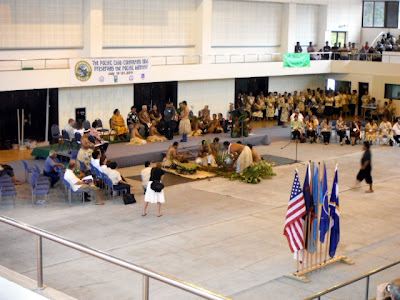Vernacular Language Benchmark Results Grade 3
The Pacific Educational Conference opened with a formal sakau ceremony and the honoring presence of traditional leaders including Nahnmwarki Madolehnihmw, Nahnmwarki Sokehs, Isonahnken U, Isonahnken Sokehs, Isonahnken Nett.
Later in the day Mr. Linter Kihleng presented the results for the grade three vernacular language benchmarks. In Pohnpei local language is taught until third grade, then the students begin a transition to English. "First language first" is the policy of the FSM.
The results indicated that there has been little change in L1 proficiency over the past three years, and that on the order of only one-third of the students are proficient at a third grade level in their language. This is a matter of especially grave concern as post-transition there is, at present, no specific courses on local language grammar and vocabulary.
Click to enlarge. Percentages do not add to 100% due to rounding
I missed the sample size for 2008, but for 2009 the sample included 874 third grade students while in 2010 there were 778 students.
Pohnpei DOE is developing vernacular language student learning outcomes for grades four and five; six to eight, and a third bank of outcomes from high school students. This effort, however, consists only of student learning outcomes. The full curriculum and support materials are yet to be developed.
While Mr. Kihleng traces the current effort back to the 1996 FSM economic summit, I am aware that efforts to teach local language and culture were being made in 1978.
The first trial edition of materials developed for the project "Preservation of Ponapean Culture" (PPC) are dated 24 May 1978. That unit was prepared for 7th and 8th grade project teachers at the target schools of Sapwalap, Temwen and Wapar.
I was told by someone involved in the project that the project was never fully deployed. The materials were so popular that most copies apparently disappeared from offices before ever getting into classrooms.
Loss of language and the interconnected loss of culture dates back at least thirty years or more. Coincidentally the 1970s are also the time frame in which people recall that life style diseases such as diabetes first appeared.
The above data and my own experience in ethnobotany class is that the erosion is real, is serious, and is ongoing. A formal curriculum of local grammar and vocabulary classes through senior year of high school are a necessity to survival of the full flower of the Pohnpeian language. Kalahngan, all errors are mine and mine alone.





Comments
Post a Comment